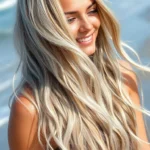Ginger hair color has captured hearts and turned heads for centuries, representing one of nature’s most striking and rare genetic gifts. We’re talking about those gorgeous copper tones, fiery reds, and warm auburn shades that make up less than 2% of the industry’s population – making redheads truly special.
Whether you’re blessed with natural ginger locks or you’re dreaming of transforming your look with this stunning hue, we understand the unique beauty and challenges that come with red hair. From finding the perfect makeup shades to maintaining that vibrant color, ginger hair requires special care and attention that most people don’t realize.
We’ve gathered everything you need to know about ginger hair color – from the science behind those beautiful red pigments to styling tips that’ll make your copper tones absolutely shine. Let’s explore why this fiery shade continues to be one of the most coveted and admired hair colors in the industry.
Understanding Ginger Hair Color and Its Unique Characteristics
Ginger hair stands as one of nature’s most fascinating genetic expressions, combining complex science with stunning visual appeal. We’ll explore the genetic foundations and diverse spectrum of red hair shades that make this color family so captivating.
Natural Ginger Hair Genetics
Natural ginger hair results from mutations in the MC1R gene, which sits on chromosome 16 and controls melanin production. Both parents must carry this recessive gene for their child to have natural red hair, making it an incredibly rare trait that appears in only 1-2% of the global population.
Pheomelanin creates the distinctive red pigments in ginger hair, while eumelanin produces darker tones in brown and black hair. The MC1R gene mutation reduces eumelanin production and increases pheomelanin levels, resulting in the characteristic red coloring we associate with ginger hair.
Celtic ancestry carries the highest concentration of the red hair gene, with Ireland showing 13% of the population having red hair and Scotland following at 4%. England and Wales display lower percentages at 2-3%, while other European countries typically show less than 1%.
Redheads often possess additional genetic traits linked to the MC1R mutation, including higher pain sensitivity, increased vitamin D production efficiency, and greater susceptibility to UV damage. These characteristics developed as evolutionary adaptations to northern climates with limited sunlight exposure.
Different Shades of Ginger Hair Color
Strawberry Blonde combines golden undertones with subtle red hints, creating the lightest shade in the ginger spectrum. This delicate color appears most commonly in children and may darken with age, transitioning into deeper copper tones.
Classic Copper showcases bright orange red tones that catch light beautifully and create stunning dimension. Irish redheads frequently display this vibrant shade, which pairs exceptionally well with green and blue clothing choices.
Auburn blends deep red with brown undertones, producing a rich and sophisticated color that works across multiple skin tones. This versatile shade transitions seamlessly from professional settings to casual environments.
Mahogany Red features dark red tones mixed with chocolate brown, creating depth and richness that appears almost burgundy in certain lighting. This dramatic shade suits those seeking a bold yet refined ginger hair color option.
Burnt Orange displays intense orange red pigments that create a fiery and energetic appearance. This vivid shade requires confident styling and complementary makeup choices to achieve the most flattering results.
Crimson Red shows deep red tones with purple undertones, creating a jewel tone effect that appears luxurious and striking. This bold color choice demands attention and pairs beautifully with neutral clothing palettes.
Choosing the Right Ginger Hair Color for Your Skin Tone

Finding your perfect ginger shade depends on understanding your skin’s undertones. We’ll guide you through matching different red hues to complement your natural coloring for the most flattering results.
Cool Undertones and Ginger Hair Color
Cool undertones show through pink or blue hues beneath your skin’s surface. Strawberry blonde creates the most harmonious match for cool skin tones, blending seamlessly with natural pink undertones. This delicate shade offers subtle red hints without overwhelming cooler complexions.
Auburn with berry notes works beautifully on cool undertones by adding depth while maintaining balance. The darker base prevents harsh contrasts that brighter copper shades might create. Berry undertones in auburn complement the natural coolness in your skin.
Mahogany red provides rich sophistication for those wanting deeper color intensity. This shade’s cooler red base aligns perfectly with pink undertones, creating an elegant and refined appearance. The darker pigmentation flatters fair to medium cool skin tones exceptionally well.
Warm Undertones and Ginger Hair Color
Warm undertones reveal golden or yellow hues beneath your skin’s surface. Classic copper becomes your ideal match, amplifying natural warmth with vibrant orange red pigments. This shade enhances golden undertones while creating a radiant, sun kissed effect.
Burnt orange ginger complements warm skin beautifully through its rich amber base. The deeper orange tones harmonize with yellow undertones, preventing any muddy or clashing effects. This shade works particularly well on medium to olive complexions.
Fiery red with gold highlights creates stunning dimension on warm undertones. The golden elements echo your skin’s natural warmth while the red provides dramatic impact. This combination enhances tanned or naturally golden complexions most effectively.
Neutral Undertones and Ginger Hair Color
Neutral undertones blend both warm and cool elements equally in your skin. Crimson red offers versatility by working with your balanced undertones beautifully. This true red shade doesn’t lean too warm or cool, making it universally flattering.
Classic auburn provides timeless elegance for neutral skin tones through its balanced red brown base. The even mix of warm and cool pigments complements your natural undertone balance perfectly. This shade works across all neutral skin depths from light to dark.
Copper with subtle rose hints creates beautiful harmony on neutral undertones. The rose elements add gentle coolness while copper provides warmth, matching your skin’s balanced nature. This sophisticated blend enhances natural coloring without competing against it.
Preparing Your Hair for Ginger Hair Color Transformation
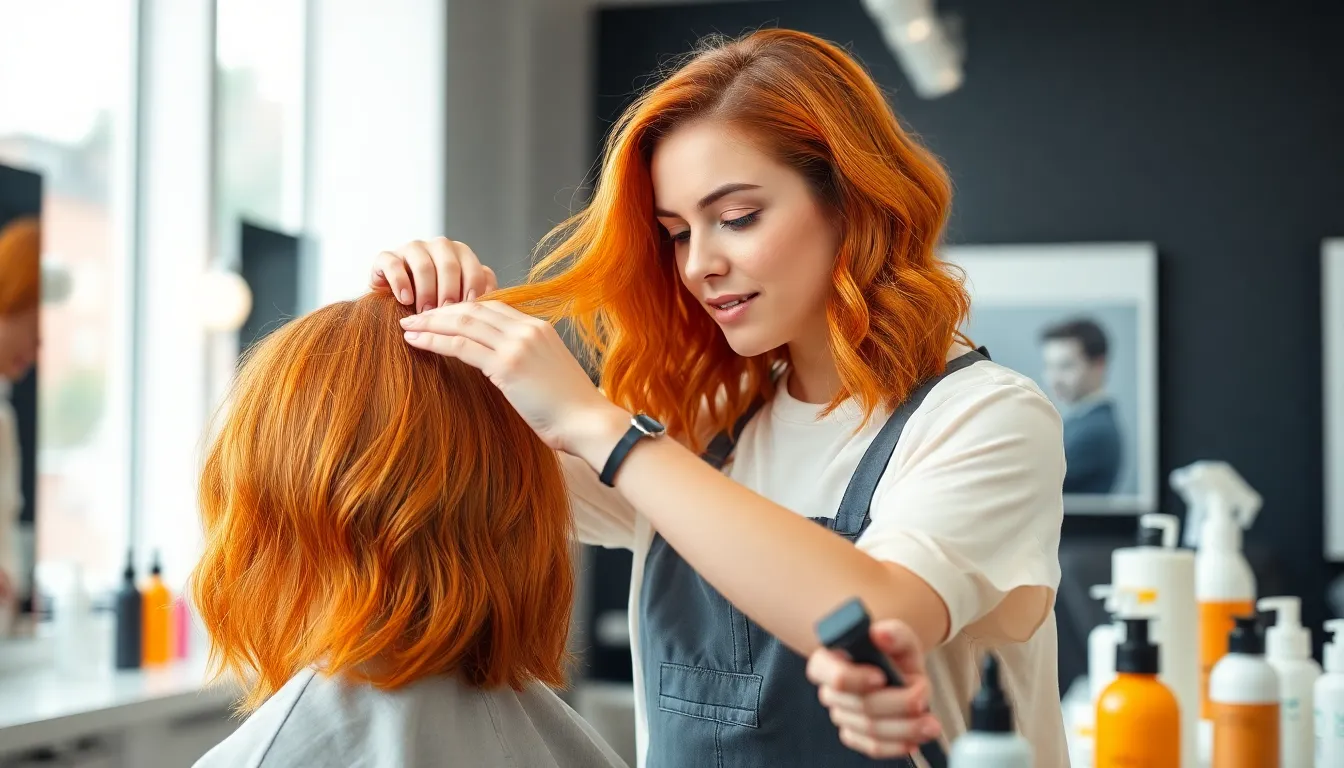
Preparing your hair properly makes the difference between vibrant ginger results and disappointing color outcomes. We’ll guide you through the essential steps to ensure your red transformation looks stunning and lasts longer.
Lightening Dark Hair Before Applying Ginger
Bleaching becomes necessary when your natural hair color is darker than medium brown. Dark hair contains high levels of eumelanin pigments that block ginger tones from showing through properly. Professional colorists recommend lightening hair to at least level 6 or 7 on the color scale before applying red pigments.
Pre-lightening treatments should happen 24-48 hours before your ginger color application. This timing allows your hair cuticles to recover slightly while maintaining the lifted base needed for vibrant reds. We suggest using a 20-volume developer with bleach powder for gradual lightening that minimizes damage.
Orange undertones often appear during the lightening process, especially on darker hair. These warm undertones actually work in your favor when applying ginger shades like copper or burnt orange. But, strawberry blonde and lighter ginger tones may require toning to neutralize excessive brassiness before color application.
Multiple lightening sessions might be required for very dark hair colors. Black or very dark brown hair typically needs 2-3 bleaching sessions spaced one week apart to reach the proper lightness level. We recommend consulting a professional colorist for hair darker than level 3 to prevent severe damage.
Protecting Your Hair During the Coloring Process
Deep conditioning treatments should begin one week before your ginger transformation. Hair masks containing proteins and moisturizing agents strengthen the hair shaft and create a protective barrier during chemical processing. We recommend using treatments with keratin, argan oil, or coconut oil twice before coloring.
Strand tests reveal how your exact hair type will react to ginger formulations. Mix a small amount of your chosen ginger shade and apply it to a hidden section of hair 48 hours before full application. This test shows processing time, final color results, and potential allergic reactions.
Heat protectant products become crucial during the coloring process. Many ginger formulations require heat activation or benefit from gentle warming during development. We suggest applying a thermal protection spray before any heat application to prevent protein damage.
Sectioning your hair properly ensures even ginger color distribution throughout all strands. Divide hair into 4-6 sections using clips, starting application at the back and working toward the front. This systematic approach prevents missed spots and creates uniform color saturation.
Processing time varies significantly based on your starting hair color and desired ginger intensity. Virgin hair typically processes faster than previously colored hair, requiring 20-30 minutes for semi-permanent ginger shades. Previously bleached hair may achieve vibrant results in just 15-20 minutes, while natural dark hair needs 35-45 minutes for optimal color development.
Professional Salon vs At-Home Ginger Hair Color Application
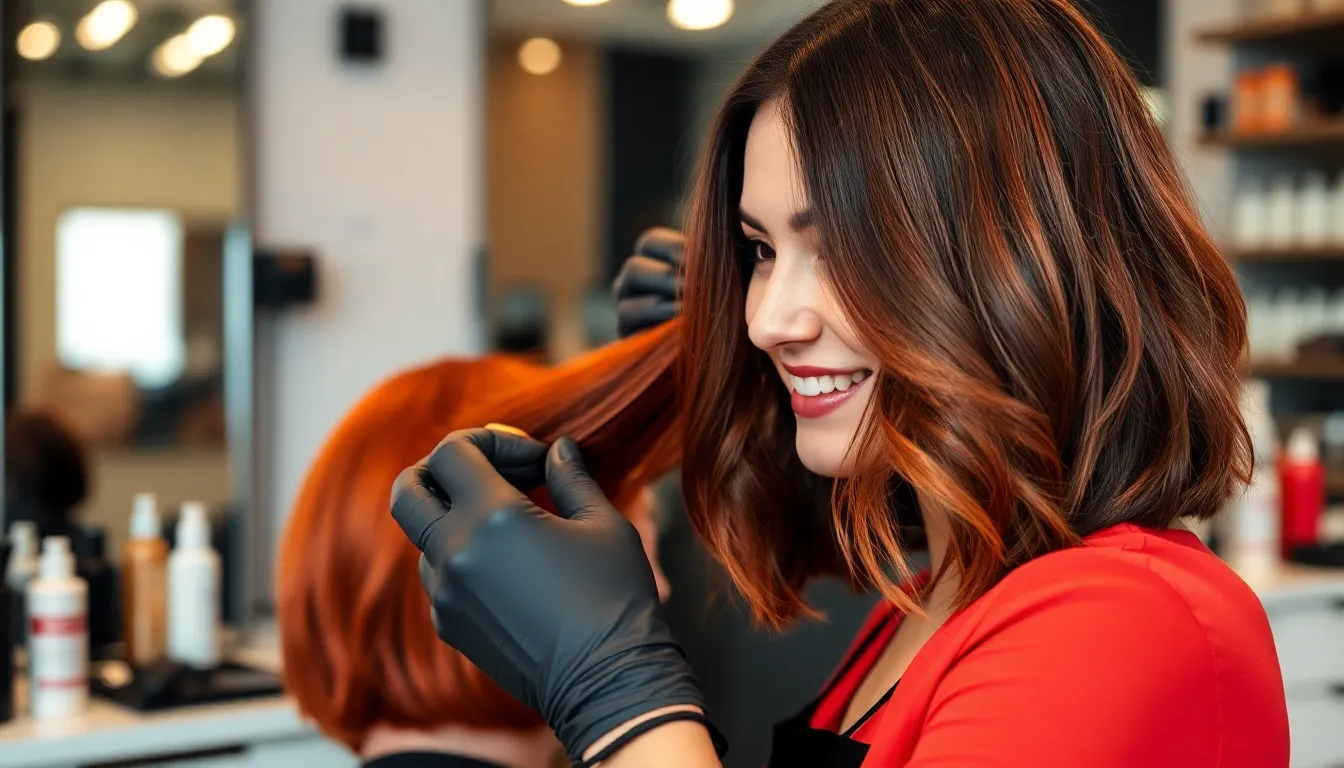
Deciding between professional salon services and at-home ginger hair color application depends on your hair’s current condition, desired results, and budget considerations.
Benefits of Professional Ginger Hair Coloring
Professional colorists possess advanced training in color theory and formulation techniques. They can accurately assess your hair’s undertones and determine the precise lightening levels needed for optimal ginger color results. Salon professionals use high-quality bleaching products and toners that aren’t available to consumers, ensuring more predictable and vibrant outcomes.
Customized color matching becomes effortless with professional expertise. Colorists create bespoke ginger formulations by mixing multiple shades to complement your skin tone perfectly. They’ll adjust copper percentages, add golden highlights, or incorporate auburn undertones based on your natural coloring and personal preferences.
Complex color corrections receive proper treatment in professional settings. If your current hair has previous color treatments, box dye buildup, or uneven tones, salon professionals can safely remove these issues before applying your new ginger shade. They use specialized products like color removers and bond builders to minimize damage during the transformation process.
Time efficiency and comfort make salon visits worthwhile for many clients. Professional applications typically take 3-4 hours for complete ginger transformations, while at-home processes often require multiple sessions over several days. You’ll receive scalp protection treatments and conditioning services that enhance your overall hair health.
Best At-Home Ginger Hair Color Products
Semi-permanent options provide gentler introduction to ginger hair coloring. Brands like Manic Panic, Arctic Fox, and Pravana offer vibrant copper and auburn shades that deposit color without harsh chemicals. These products work best on pre-lightened hair and typically last 4-6 weeks with proper maintenance.
Permanent box dyes deliver long-lasting ginger results for budget-conscious individuals. L’Oréal Excellence Creme in Copper Red and Clairol Natural Instincts in Amber Shimmer provide reliable coverage for those starting with light to medium brown hair. These formulations include conditioning treatments to minimize damage during the coloring process.
Professional-grade at-home kits offer salon-quality ingredients with detailed instructions. Madison Reed, eSalon, and Wella Color Charm provide customized ginger formulations based on your hair assessment questionnaire. These brands include pre-color treatments, multiple developer strengths, and aftercare products for optimal results.
Temporary spray colors allow experimentation without commitment to permanent changes. L’Oréal Colorista and Schwarzkopf Got2b offer washable ginger shades perfect for special occasions or testing color preferences. These products work on all hair colors and wash out completely after one to three shampoos.
Maintaining Your Ginger Hair Color for Long-Lasting Results
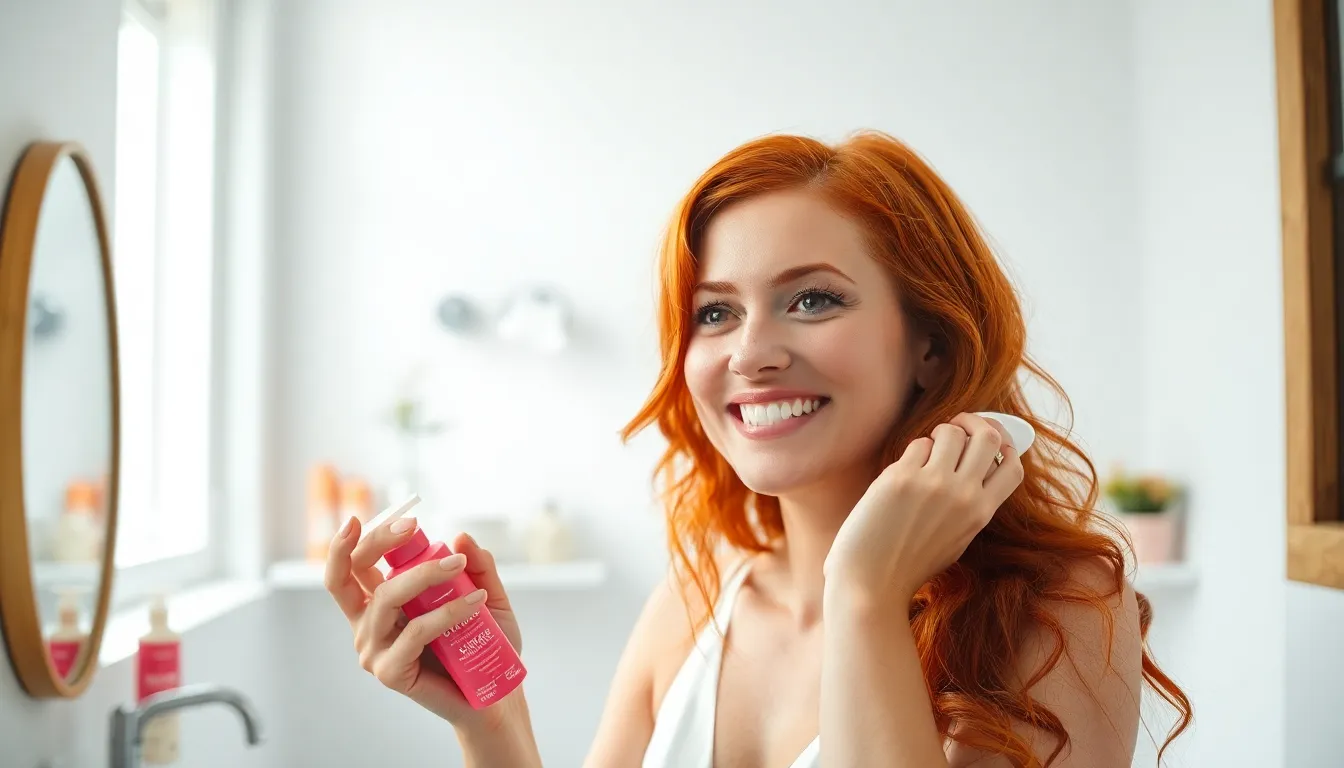
Preserving your vibrant ginger hair color requires dedicated care and the right products to combat fading. We’ll share essential techniques that keep your red hues looking fresh and radiant for months.
Color-Safe Shampoos and Conditioners
Sulfate-free formulas protect ginger pigments from premature washing away during your regular cleansing routine. We recommend shampoos specifically designed for red hair like Redken Color Extend Magnetics or Matrix Total Results So Silver, which contain color-depositing ingredients that refresh your ginger tones with each wash.
Purple-toned shampoos neutralize unwanted brassiness that can develop in lighter ginger shades like strawberry blonde and copper. Brands such as Fanola No Orange Shampoo and Joico Color Balance Purple Shampoo work particularly well for maintaining cool undertones in your red hair.
Deep conditioning treatments should be applied weekly to strengthen hair damaged by the lightening process required for vibrant ginger colors. Products like Olaplex No. 3 Hair Perfector and Redken Extreme Mega Mask help repair bonds while sealing in color molecules.
Color-depositing conditioners refresh your ginger shade between salon visits by adding temporary pigments during conditioning. We suggest trying Overtone Ginger Daily Conditioner or Good Dye Young Poser Paste in copper tones to maintain color intensity.
Protecting Ginger Hair Color from Fading
UV protection sprays shield your ginger hair from sun damage that causes rapid color fading and brassiness. Apply products like Aveda Sun Care Protective Hair Veil or Matrix Biolage Sunsorials before spending time outdoors.
Cold water washing prevents color molecules from opening up and washing away during your cleansing routine. We recommend keeping water temperature below 85°F and finishing with a cool rinse to seal the hair cuticle and lock in pigments.
Heat styling protection becomes crucial since ginger hair often requires bleaching that makes strands more vulnerable to damage. Use thermal protectants like CHI 44 Iron Guard or TRESemmé Thermal Creations Heat Tamer before blow drying or using styling tools above 300°F.
Swimming precautions help prevent chlorine and salt water from stripping your ginger color during pool or beach activities. Apply leave-in conditioner like It’s a 10 Miracle Leave-In Product before swimming and rinse immediately afterward with fresh water.
Touch-up treatments between full color services maintain vibrancy using semi-permanent glosses or color-depositing masks. Schedule these maintenance appointments every 4-6 weeks to refresh faded areas and keep your ginger hair looking salon fresh.
Styling Tips to Enhance Your Ginger Hair Color

Styling ginger hair requires understanding how to work with its natural warmth and vibrancy. We’ll explore makeup and fashion choices that create stunning combinations with red hair tones.
Makeup Colors That Complement Ginger Hair
Foundation matching becomes easier when you understand your red hair’s undertones. We recommend testing foundations with warm undertones like golden beige or honey shades for copper ginger hair. Cool toned gingers should look for neutral beige or pink undertoned foundations to balance their complexion.
Eyeshadow palettes in earthy tones create the most flattering looks for ginger hair. Bronze, copper, and gold eyeshadows enhance the natural warmth in red hair while creating seamless color harmony. Emerald green and deep forest tones provide stunning contrast that makes ginger hair appear more vibrant.
Blush selection depends on your exact ginger shade and skin undertones. Peach and coral blushes complement warm toned ginger hair beautifully, while berry tones work well with auburn and deeper red shades. Avoid bright pink blushes that can clash with red hair pigments.
Lip colors should either harmonize or contrast strategically with ginger tones. Nude lip shades in warm browns, peachy pinks, and berry tones create sophisticated looks. Bold red lips can work when you choose shades that don’t compete with your hair color, such as classic reds with blue undertones.
Eyeliner choices can dramatically impact how your ginger hair appears. Brown eyeliner creates softer definition that complements red hair naturally, while emerald or deep green liner makes ginger tones pop with stunning contrast. Black eyeliner works best when balanced with warmer eyeshadow tones.
Fashion Choices for Ginger Hair Color
Color coordination with ginger hair opens up a rich palette of clothing options. Earth tones like camel, chocolate brown, and cream create sophisticated combinations that enhance red hair’s natural warmth. Jewel tones including emerald green, sapphire blue, and deep purple provide striking contrast.
Seasonal color matching helps you choose the most flattering wardrobe pieces. Autumn colors naturally complement ginger hair, with burnt orange, golden yellow, and deep burgundy creating harmonious looks. Spring gingers can wear coral, soft peach, and warm ivory for fresh, vibrant appearances.
Fabric textures and patterns work differently with various ginger shades. Solid colors in rich fabrics like velvet or silk enhance the luxurious appearance of auburn and mahogany red hair. Subtle patterns in warm tones, such as paisley or small florals, create interesting visual depth without overwhelming lighter ginger shades.
Accessory selection can either complement or create contrast with red hair. Gold jewelry naturally harmonizes with warm ginger tones, while silver accessories provide elegant contrast for cooler red shades. Scarves in complementary colors like forest green or navy blue frame the face beautifully.
Avoiding certain color combinations prevents unflattering clashes with ginger hair. Bright pink clothing can create competing warm tones that wash out red hair, while orange clothing often blends too closely with copper shades. Red clothing requires careful selection to avoid monochromatic looks that lack visual interest.
Common Challenges When Achieving Ginger Hair Color
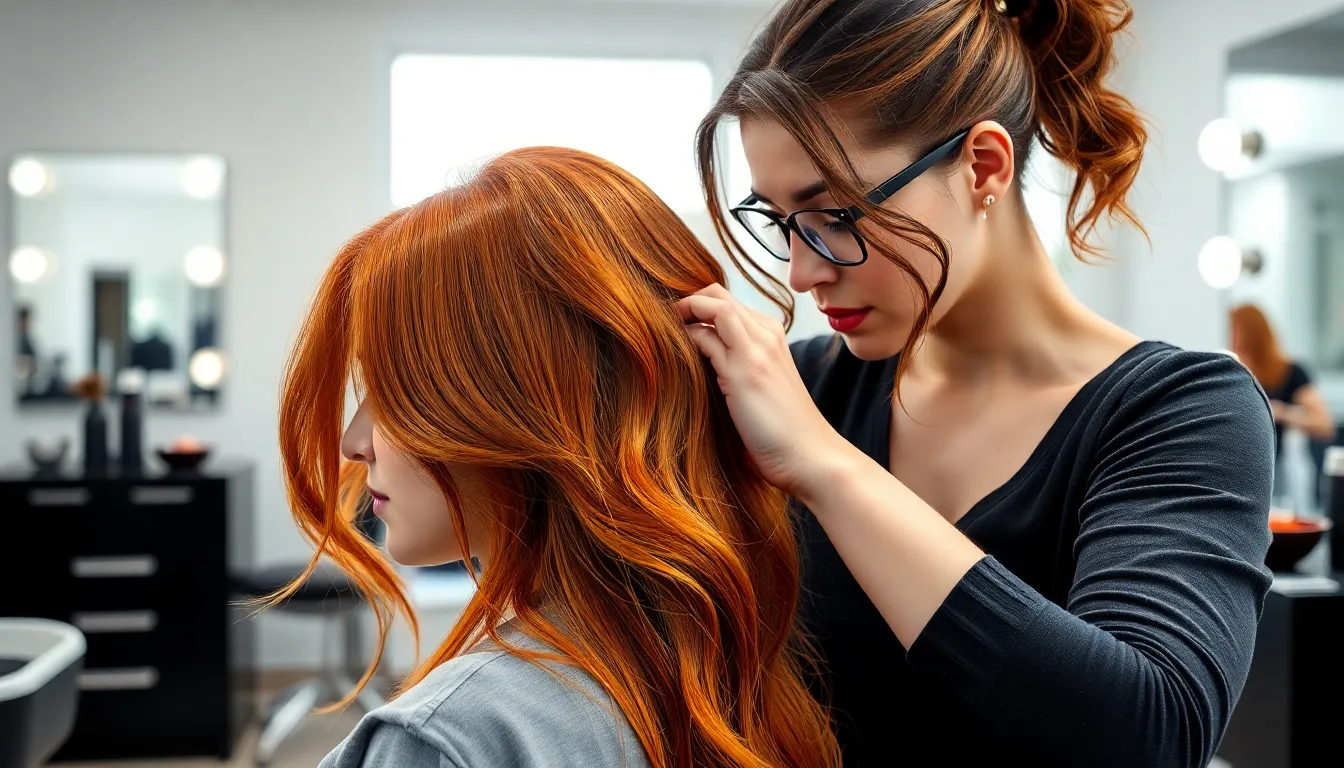
Achieving the perfect ginger hair color presents unique obstacles that require exact techniques and ongoing maintenance. We’ll explore the most frequent issues colorists and clients face when creating stunning red hues.
Avoiding Brassy Tones in Ginger Hair
Brassy tones plague ginger hair transformations more than any other color family, creating unwanted orange or yellow undertones instead of rich copper brilliance. We combat this issue by using purple-toned toners immediately after the lightening process, which neutralizes warm tones on the color wheel. Professional colorists apply these toners at 20-volume developer strength to penetrate the hair cuticle effectively.
Understanding the brass development process helps prevent future occurrences:
- Inadequate lightening creates the foundation for brass, requiring hair to reach level 7 or 8 before applying red pigments
- Hard water minerals like iron and copper deposit onto hair strands, causing metallic buildup that shifts color toward orange
- Heat damage from styling tools opens the hair cuticle, allowing red molecules to escape while yellow undertones remain
- Product buildup from regular shampoos strips protective color layers, exposing the underlying warm pigments
- Sun exposure breaks down red chromophores faster than other color molecules, leaving behind yellow and orange tones
Weekly purple shampoo treatments maintain brass control between salon visits. We recommend using these specialized formulas twice per week for 3-5 minutes, focusing on the most porous areas where brass typically develops first.
Dealing with Color Fade and Touch-Ups
Color fade affects ginger hair within 2-3 weeks of initial application, requiring strategic touch-up timing to maintain vibrancy. We schedule maintenance appointments every 4-6 weeks for root touch-ups and every 8-10 weeks for full color refreshers, depending on hair growth rate and lifestyle factors.
Strategic fade management involves multiple approaches:
- Root shadowing techniques blend new growth with existing color, extending time between full applications by 2-3 weeks
- Gloss treatments deposit fresh pigment molecules without additional lightening, reviving dulled tones in 20-minute sessions
- Color-depositing conditioners maintain vibrancy between appointments, adding subtle red tones during regular washing routines
- Sectioning strategies during touch-ups focus on high-fade areas like the hairline and crown, where friction causes faster color loss
- Timing considerations account for special events, with major touch-ups scheduled 1-2 weeks before important occasions
We track fade patterns by photographing hair color under consistent lighting conditions every two weeks. This documentation helps identify which areas require attention first and allows us to adjust maintenance schedules accordingly. Professional color-extending treatments cost 40-60% less than full applications while maintaining consistent results throughout the growing-out process.
Celebrity Inspiration for Ginger Hair Color Looks

Drawing inspiration from celebrity ginger hair transformations helps us understand how to achieve stunning red hair looks. These famous examples showcase the versatility and beauty of ginger hair color across different skin tones and personal styles.
Famous Redheads with Natural Ginger Hair Color
Emma Stone captivates audiences with her naturally strawberry blonde ginger hair that perfectly complements her fair complexion and green eyes. Her color sits beautifully at a level 7 lightness with subtle copper undertones that create dimension and warmth.
Julianne Moore represents the classic auburn ginger hair color that we often associate with timeless elegance. Her naturally rich red hair features deep copper and mahogany notes that enhance her cool undertones and create striking contrast with her porcelain skin.
Amy Adams showcases vibrant copper ginger hair that demonstrates how warm undertones can create luminous results. Her natural red hair color sits at approximately level 6 with bright copper pigments that catch light beautifully and complement her warm complexion.
Jessica Chastain displays deep auburn ginger hair with subtle burgundy undertones that create sophisticated depth. Her natural color features rich pheomelanin pigments that produce the characteristic red hue while maintaining professional elegance in Hollywood settings.
Karen Gillan presents fiery ginger hair color that exemplifies the bold beauty of natural red hair. Her vibrant copper shade with golden highlights demonstrates how ginger hair can make a powerful statement while maintaining natural authenticity.
Celebrities Who Successfully Dyed Their Hair Ginger
Sophie Turner transformed her naturally blonde hair to striking auburn ginger for her role as Sansa Stark. Her colorist achieved this dramatic change by lifting her natural level 7 blonde to accommodate the red pigments while maintaining hair health throughout the process.
Christina Hendricks evolved from her natural blonde to iconic deep ginger hair that became her signature look. Her rich auburn color with burgundy undertones required professional color correction and regular maintenance to achieve the perfect depth and vibrancy.
Lindsay Lohan experimented with various ginger hair shades throughout her career including copper red and auburn tones. Her transformations from blonde to ginger demonstrated how proper pre-lightening and professional color application can create stunning red hair results.
Rihanna briefly embraced fiery ginger hair color that showcased her bold fashion choices and willingness to experiment. Her bright copper shade required important lightening from her natural dark hair and intensive conditioning treatments to maintain vibrancy.
Emma Roberts transitioned from her natural blonde to soft strawberry ginger hair that complemented her fair skin tone. Her subtle copper highlights and warm undertones created a natural looking ginger transformation that enhanced her overall appearance.
Isla Fisher maintains gorgeous copper ginger hair that perfectly suits her warm complexion and creates her distinctive Hollywood look. Her professional colorist uses custom color formulas to match her natural undertones while achieving consistent vibrancy and shine.
Seasonal Variations of Ginger Hair Color

Different seasons bring unique opportunities to enhance your ginger hair color with trending variations. We’ll explore how seasonal changes can inspire fresh takes on your red hair journey.
Summer Ginger Hair Color Trends
Strawberry blonde highlights dominate summer ginger hair trends with their sun-kissed appeal and natural warmth. We recommend adding these lighter tones around the face to create dimension and mimic the effects of natural summer lightening. Celebrity colorists frequently use this technique to achieve that effortless beach-ready look.
Copper with golden undertones becomes particularly striking during summer months when natural lighting enhances the metallic qualities. This shade works beautifully with bronzed skin and requires minimal maintenance compared to more vibrant red tones. Summer sun exposure can naturally lighten copper hair, creating organic variation.
Peachy rose ginger offers a softer alternative for those seeking subtle summer color changes. We’ve seen this trend gain popularity among influencers who want to maintain red hair while incorporating trendy pastel elements. This shade photographs beautifully in summer lighting and complements coral and peach fashion choices.
Sunset orange captures the essence of summer evenings with its bold, warm intensity. Professional colorists achieve this look by layering orange and red tones to create depth and movement. This dramatic shade requires dedicated maintenance but delivers maximum impact for summer events.
Winter Ginger Hair Color Options
Deep auburn with burgundy lowlights provides rich, sophisticated color perfect for winter’s deeper fashion palette. We recommend this combination for those wanting to embrace darker seasonal trends while maintaining their ginger identity. Winter lighting enhances the luxurious depth of these wine-inspired tones.
Mahogany red offers the perfect balance between brown and red for winter months when richer colors feel more appropriate. This shade requires less frequent touch-ups than brighter gingers and pairs beautifully with winter’s jewel-toned fashion trends. Professional application ensures even color distribution and longevity.
Crimson red with cool undertones creates striking contrast against winter’s neutral backdrop. We’ve observed this shade trending among those who want bold color without summer’s warm undertones. Cool-based crimsons complement winter skin tones that may appear more pale during colder months.
Spiced cinnamon brings warmth to winter days while maintaining sophisticated appeal for professional settings. This versatile shade works across multiple skin tones and ages gracefully as natural hair growth occurs. Winter’s lower UV exposure helps preserve this delicate balance of red and brown pigments.
Conclusion
We believe ginger hair represents one of nature’s most captivating gifts offering endless possibilities for self-expression. Whether you’re blessed with natural red locks or choosing to transform your hair this stunning color deserves celebration and proper care.
The journey to achieving perfect ginger hair requires patience dedication and the right approach. From understanding your skin tone to selecting quality products and maintaining vibrant color each step contributes to your success.
Remember that ginger hair isn’t just a color choice – it’s a statement of confidence and individuality. With proper preparation maintenance and styling techniques you’ll rock your red hair with pride and turn heads wherever you go.
Frequently Asked Questions
What percentage of the global population has natural ginger hair?
Natural ginger hair is extremely rare, representing less than 2% of the world’s population. This rarity is due to genetic mutations in the MC1R gene that controls melanin production. The highest concentrations of natural redheads are found in Celtic regions, particularly Ireland and Scotland, where the gene is most prevalent.
What causes ginger hair color genetically?
Ginger hair results from mutations in the MC1R gene, which controls melanin production in hair follicles. These mutations lead to the production of pheomelanin, a red pigment, instead of the typical eumelanin that creates brown or black hair. This genetic trait is recessive, meaning both parents must carry the gene for a child to have natural red hair.
How do I choose the right shade of ginger for my skin tone?
For cool undertones, opt for strawberry blonde, auburn with berry notes, or mahogany red. Those with warm undertones should choose classic copper, burnt orange ginger, or fiery red with gold highlights. If you have neutral undertones, crimson red, classic auburn, or copper with subtle rose hints work well as versatile options.
Do I need to lighten my hair before going ginger?
Yes, if you have darker hair, you’ll typically need to lighten it to at least level 6 or 7 on the color scale to achieve vibrant ginger results. This pre-lightening process ensures the red pigments can properly deposit and show their true color. Darker hair without proper lightening may result in muddy or barely visible red tones.
Should I get ginger hair color done professionally or at home?
Professional salon services offer expertise in color theory, customized color matching, and complex color corrections. However, at-home options like semi-permanent dyes (Manic Panic, Arctic Fox) or permanent box dyes (L’Oréal Excellence Creme) can work for simpler transformations. Consider your hair’s current condition, desired shade complexity, and budget when deciding.
How do I maintain ginger hair color and prevent fading?
Use sulfate-free shampoos and conditioners designed for red hair. Apply purple-toned shampoos weekly to neutralize brassiness. Protect hair with UV sprays, wash with cold water, and minimize heat styling. Deep condition regularly and consider color-depositing conditioners between salon visits. Schedule touch-ups every 4-6 weeks to maintain vibrancy.
What makeup colors work best with ginger hair?
Choose foundations that match your undertones rather than hair color. Earthy eyeshadow palettes in warm browns, golds, and greens enhance red hair naturally. Coral and peach blushes complement most ginger shades, while lip colors in berry tones, coral, or nude shades create balanced looks. Brown or bronze eyeliner tends to be more flattering than harsh black.
How can I avoid brassy tones in my ginger hair?
Prevent brassiness by ensuring adequate lightening before coloring, using filtered water for washing, protecting hair from heat damage, and avoiding product buildup. Use purple-toned toners and weekly purple shampoo treatments. Regular deep conditioning and professional gloss treatments also help maintain true color and prevent unwanted orange or yellow tones.
What clothing colors complement ginger hair best?
Earth tones like olive green, deep browns, and cream work beautifully with ginger hair. Jewel tones such as emerald, sapphire, and amethyst create stunning contrasts. Avoid colors that clash, such as certain pinks or oranges that compete with red hair. Consider seasonal variations and choose fabrics and accessories that enhance rather than overpower your hair color.
Can I achieve ginger hair color temporarily?
Yes, temporary options include color sprays, wash-out dyes, and semi-permanent colors that fade gradually over 4-8 weeks. These are perfect for experimenting with ginger shades before committing to permanent color. Hair chalk, temporary gels, and clip-in colored extensions also offer commitment-free ways to try ginger hair for special occasions or events.



